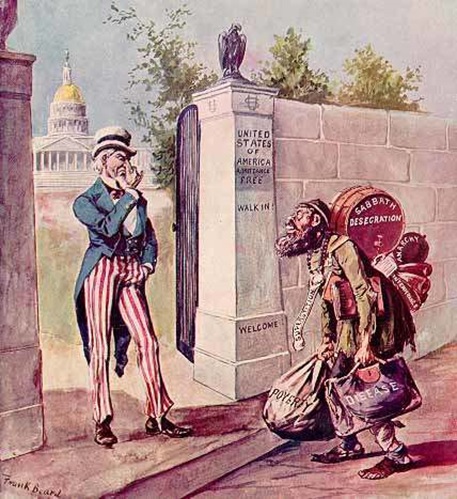Working with Cartoons
How to prepare
To improve your skills and to prepare for cartoon analysis,
- revise descriptive phrases (body postures, shapes, patterns…),
- learn some technical terms (panel, motion lines, captions…),
- browse the WWW for good cartoons,
- study the symbols that are commonly used in political cartoons,
- check out some of the familiar faces that might show up in a cartoon,
- practise how to structure your work, following the conventions (from large forms to lesser forms, from botton to top, from left to right…).
First Step: Source
Before you start to analyse the interpret the cartoon, make sure you have checked its source. Unfortunately, many teachers don’t bother to write down details about the origin of the cartoon. Such details are important:
- Does the cartoon have a title?
- When was it published?
- In which medium?
- Who is the cartoonist?
- Which material has been used?
- Is there any context?
Second Step: Analysis
Next, take a pencil to identify and annotate all graphic and verbal elements in the cartoon. It is important to identify…
- the main characters;
- the situation they’re in;
- the environment (background, middle ground);
- also, look for captions, speech bubbles and other text (like imprints on the characters’ clothing).
- If there is a title, take a closer look – more often than not, it will offer keys for interpretation.
Third Step: Interpretation
Once you have identified all the relevant details, find out:
- Which problem is addressed in the cartoon,
- from whose perspective,
- for which group of people,
- whether there are references to famous people, events, documents or buildings,
- which message the cartoonist is trying to get across,
- how various elements in the cartoon support this message,
- whether there are various layers of meaning,
- if irony is involved or whether one can take the message at its face value.
Fourth Step: Assessment
After your interpretation, you might be asked to comment on the cartoon. In this case,
- express your thoughts on how relevant and how topical the cartoon is,
- why it is persuasive and effective in making its point,
- whether the cartoonist’s position is justifiable from your point of view
- or in how far it attracts criticism.
Glossary
Phrases for Description
- The cartoon consists of a single panel / two frames separated by a narrow gutter / a series of three boxes / two tiers with three panels each.
- In the foreground you can see …
- The background is covered with …
- Motion lines next to … indicate that …
- The text in the speech bubble says …
- The character on the right is portrayed in a realistic manner …
- … , whose nose is out of proportion, …
- … is depicted as / in the form of …
- A thought balloon informs us about the character’s intentions: …
- Below the cartoon, there is a caption which says …
- The cartoon uses sound effects to …
- The word balloon has a dashed / dotted / jagged outline
- Smaller font is used in the captions: …
- The gray / bold lettering of the word “…” indicates …
- Small capitals / italics are used to emphasize that …
- There is a rectangular box in the top left corner …
- A series of Z’s makes clear that … is fast asleep.
- The caption takes the form of a speech scroll. It says …
Phrases for Interpretation
- … is a symbol of …
- … stands for …. / … represents … / … symbolizes …
- The cartoonist attacks / ridicules / pokes fun of / makes fun of / supports the idea that… / disapprove of / expresses his strong disapproval of … / shows a slight tendency to … / seems to be biased against …
- The cartoon illustrates the idea that … / criticizes … for / satirizes … / is extremely critical of …
- The character on the left, … , can be seen as an allegory of …
- The cartoonist may want to convey that …
- His message is that …
- It’s his intention to show …
- The cartoon is supposed to …
- The cartoon implies that …
- At first glance one might think that … but a closer analysis shows that…
- You could draw the conclusion that …
- The cartoon refers to …
- The symbol in the lower left corner is a reference / an allusion to …
- The cartoonist alludes to
- On the figurative / symbolic level, … means that …
- The cartoon exaggerates certain character traits of … : …
- … is a slight / gross exaggeration of …
- … is a satirical description of …
- The cartoonist is apparently an outspoken critic of …
Cartoon Analysis: Example
 |
Title: The Immigrant: The Stranger at our Gate Captions: EMIGRANT. – Can I come in? UNCLE SAM. – I ‘spose you can; there’s no law to keep you out. Labels: Gatepost: “United States of America / Entrance Free” “Walk in” “Welcome” Emigrant: Barrel: Sabbath desecration Additional Bag: Anarchy Kitbag: Poverty Handbag: Disease Prayer shawl: Supersition Source: Chicago: The Ram’s Horn Press, 1899; today: Cartoon Research Library of Ohio State University. |
Cartoon Analysis: “The Immigrant: The Stranger at our Gate”
The cartoon “The Immigrant: The Stranger at our Gate” was published as a political statement by the Chicago-based Ram’s Horn Press in 1899. It deals with the problems that are supposedly caused by the influx of undocumented immigrants. Apparently, the cartoonist accuses immigrants of being the source of many problems that occur in the wake of immigration. It needs to be said that the cartoon is clearly antisemitic.
The cartoon presents a scene at a fictional garden gate in Washington. The garden represents the United States. A massive wall of bricks separates US territory from the outside depicted as an ordinary country road. In the background, you can see a wide open lawn and the Capitol while the left-hand side is occupied by Uncle Sam. He is facing a Jewish immigrant looking very much like a peddler. A short dialogue between the landlord and his unwanted visitor can be found in the captions. The immigrant asks permission to enter the US and, due the fact there are no immigration laws (“no law to keep you out”), Uncle Sam cannot stop him.
From his majestic posture and the fact that he is sided by a bronze cast of the American eagle on top of the garden post, we can conclude the cartoonist sympathizes with Uncle Sam. Uncle Sam wears his stereotypical top hat his striped trousers. He seems to be holding his breath, which implies that his visitor has an awful smell.
The Jewish peddler is an impersonation of all the problems that may occur with illegal immigrants in the early 1900s. On his back, he is carrying a barrel that is labelled “Sabbath desecration” in capital letters, which can be seen as an allusion to immigrants doing Sunday work. In his right hand he is holding a large kitbag imprinted with the word “Poverty”, while he is transporting a handbag with the words “Disease” in his left hand. The inscriptions “Anarchy” on another small bag and “Superstition” on a prayer shawl underline that this Jewish immigrant is in opposition to the values of the US. With his ragged appearance and his humble posture, he looks like a caricature of the typical Jewish immigrant from Russia in the late 1800s. His long nose, his bulging lips and his black beard make the racist cliché complete.
While the inscriptions on the gate post seem like an invitation to all kinds of people, the cartoonist seems to be extremely biased towards immigrants. He highlights the risks and dangers of uncontrolled immigration and puts Uncle Sam (an allegory of the United States) in a position from which he can easily block the gate.
